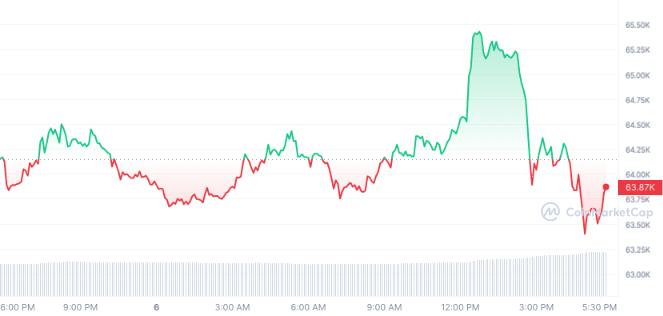On the morning of May 6, the price of Bitcoin (BTC) exceeded $65 thousand. Over the past seven days, the price of the asset has dropped below $57 thousand. The cryptocurrency market has finally begun to recover. Let’s look at what factors helped the first cryptocurrency enter the new week with significant growth.
Bitcoin Responds to Fed Meeting
According to coinmarketcap, over the past 24 hours, the Bitcoin rate has strengthened by 2.3%, and the price slightly went down. However, at the time of writing, BTC is trading at $63,860.

The last meeting of the US Federal Reserve System (FRS) on May 1 had a positive impact on the dynamics of the crypto market. During his speech, the chairman of the regulator, Jerome Powell, said that an increase in the key rate in the near future is unlikely. However, they are also not going to reduce them in the short term. Currently, interest rates in the US are at record highs. The Fed is still battling high inflation caused by the COVID-19 pandemic.
High interest rates increase borrowing costs. Therefore, investors switch to fixed income assets (such as bonds). Interest in riskier assets (for example, cryptocurrencies) is weakening, which leads to an outflow of capital from the crypto market and a decrease in token prices. Meanwhile, the next Fed meeting is scheduled for June 12. More than 90% of market participants believe that the regulator will keep the key rate at the same level. At the same time, 50% of them expect that by September the figure may finally begin to decline.
Spot Bitcoin ETFs with inflows again
Investors have been steadily withdrawing funds from Bitcoin spot ETFs since late last month. Thus, according to Farside Investors, from April 24 to May 2, a total of $1.2 billion flowed out of the new instrument.

The maximum outflow of funds occurred on May 1 – $563.8 million. At the same time, the iShares Bitcoin Trust (IBIT) fund from BlackRock went negative for the first time. However, analysts urged not to worry too much about this: “The new ETFs work smoothly across the board. Inflows and outflows are part of the norm in fund life,” wrote Bloomberg’s Eric Balchunas.
On the last trading day, the negative trend finally broke. On May 3, a total of $378 million was invested in spot Bitcoin ETFs. As a result, the total inflow since January of this year exceeded $11.5 billion. However, on April 30th, trading of spot ETFs for Bitcoin and Ethereum (ETH) started in Hong Kong. In terms of trading volume, they are very far from their American counterparts. As of May 6, Hong Kong funds totaled just over $7 million, while U.S. ETF trading volume topped $1.8 billion on Friday.
At The End
However, the appearance of such a tool on the Asian market is definitely a positive factor that will contribute to the wider acceptance of cryptocurrencies. Earlier, the vice president of digital assets at Fidelity spoke about the growing interest of institutional investors in financial products based on cryptocurrencies. The same dynamics are observed at BlackRock. American pension funds that are eyeing crypto ETFs currently have $4 trillion under management.












